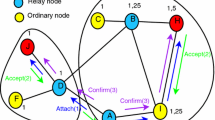Abstract
Many efforts have been done to better exploit multiple radios and multiple channels to improve system performance in wireless mesh networks. However, in the case of the IEEE 802.11b/g/n family of standards, there are only three non-overlapping channel, the simple use of orthogonal channels cannot effectively eliminate the interference. The simultaneous use of multiple partially overlapping channels has been certified as an effective way to further eliminate interference and improve network performance in 802.11-based wireless mesh networks. Good network topological structure can lead to low interference, load balancing and high throughput. This research looks into the problem of topology control and partially overlapping channel assignment to improve the performance of multi-radio multi-channel multirate wireless mesh networks. We propose an optimal topology control algorithm and greedy channel assignment algorithm to maximize the network capacity (in term of each node’s traffic delivery ratio). Simulation results present that our topology control and partially overlapping channel assignment method can dramatically improve system throughput.




Similar content being viewed by others
References
J. Jun and M. L. Sichitiu, The nominal capacity of wireless mesh networks, IEEE Wireless Communications, Vol. 10, p. 8C14, 2003.
A. Mishra, E. Rozner, S. Banerjee, and W. Arbaugh, Exploiting partially overlapping channels in wireless networks: turning a peril into an advantage. In Proceedings of the 5th ACM SIGCOMM Conference on Internet Measurement, 2005.
S. Kashif, Topology control in wireless mesh networks, NUST-SEECS, 2014.
J. Babu and P. Kumar, Improves network capacity using topology control in wireless network, International Journal of Advanced Research in Computer and Communication Engineering, Vol. 4, No. 2, p. 184C186, 2015.
J. Jia, J. Chen, J. Yu, and X. Wang, Joint topology control and routing for multi-radio multi-channel wmns under sinr model using bio-inspired techniques, Applied Soft Computing, Vol. 32, No. C, p. 49C58, 2015.
E. Maleki and G. Mirjalily, Fault-tolerant interference-aware topology control in multi-radio multi-channel wireless mesh networks, Computer Networks, Vol. 110, p. 206C222, 2016.
A. H. M. Rad and V. W. Wong, Partially overlapped channel assignment for multi-channel wireless mesh networks. In IEEE International Conference on Communications (ICC), 2007, pages 1–6, 2007.
Z. Feng and Y. Yang, How much improvement can we get from partially overlapped channels. In Wireless Communications and Networking Conference (WCNC), pages 2957–2962, 2008.
Y. Liu, R. Venkatesan, and C. Li, Channel assignment exploiting partially overlapping channels for wireless mesh networks. In IEEE Global Telecommunications Conference (GLOBECOM), 2009, pages 1C5, Dec 2009.
V. Bukkapatanam, A. A. Franklin, and C. S. R. Murthy, Using partially overlapped channels for end-to-end flow allocation and channel assignment in wireless mesh networks. In IEEE International Conference on Communications (ICC), 2009.
M. A. Hoque, X. Hong, and F. Afroz, Multiple radio channel assignment utilizing partially overlapped channels. In IEEE Global Telecommunications Conference (GLOBECOM), 2009.
L. Xiang and J. Luo, Joint channel assignment and link scheduling for wireless mesh networks: Revisiting the partially overlapped channels. In IEEE 21st International Symposium on Personal Indoor and Mobile Radio Communications (PIMRC), 2010.
P. Duarte, Z. Fadlullah, K. Hashimoto, and N. Kato, Partially overlapped channel assignment on wireless mesh network backbone. In IEEE Global Telecommunications Conference (GLOBECOM), 2010.
P. Duarte, Z. Fadlullah, A. Vasilakos, and N. Kato, On the partially overlapped channel assignment on wireless mesh network backbone: A game theoretic approach, IEEE Journal on Selected Areas in Communications, Vol. 30, No. 1, p. 119C127, 2010.
B. Jaumard, A. Voruganti, and M. Kaddour, Assigning and scheduling partially overlapping channels in wireless mesh networks. In IEEE International Conference on Wireless and Mobile Computing (WiMob), 2013.
K. Zhou, X. Jia, L. Xie, Y. Chang, and X. Tang, Channel assignment for WLAN by considering overlapping channels in sinr interference model. In International Conference on Computing Networking and Communications (ICNC), 2012, pages 1005–1009, 2012.
Y. Ding, Y. Huang, G. Zeng, and L. Xiao, Using partially overlapping channels to improve throughput in wireless mesh networks, IEEE Transactions on Mobile Computing, Vol. 11, p. 1720C1733, 2012.
F. Bokhari and G. Zaruba, i-POCA: Interference-aware partially overlapping channel assignment in 802.11-based meshes. In 14th International Symposium on a World of Wireless, Mobile and Multimedia Networks (WoWMoM 2013), pages 1C6, 2013.
Y. Xu, Q. Wu, J. Wang, L. Shen, and A. Anpalagan, Opportunistic spectrum access using partially overlapping channels: Graphical game and uncoupled learning, IEEE Transactions on Communications, Vol. 61, No. 9, p. 3906C3918, 2013.
K. Zhou, X. Jia, Y. Chang, and X. Tang, Partially overlapping channel assignment for wlans using sinr interference model, International Journal of Communication Systems, Vol. 27, No. 11, p. 3082C3095, 2014.
J. Wang and W. Shi, Partially overlapped channel assignment for multi-channel multi-radio wireless mesh networks, Eurasip Journal on Wireless Communications and Networking, Vol. 2015, p. 1C12, 2015.
J. Wang and W. Shi, Partially overlapped channels- and flow-based endto-end channel assignment for multi-radio multichannel wireless mesh networks, China Communications, Vol. 13, No. 4, p. 1C13, 2016.
M. Burton, Channel Overlap Calculations for 80211b Networks. Cirond Technologies Inc., Technical Report, White Paper, Nov. 2002.
Acknowledgements
This work is partially supported by the Natural Science Foundation of Guangdong Province, China (Grant Nos. 2014A030310375, 2014A030313631, 2016A010101037) and National Natural Science Foundation of China (Grant Nos. 61402105, 61703102).
Author information
Authors and Affiliations
Corresponding author
Rights and permissions
About this article
Cite this article
Zhou, K., Yuan, H., Zhang, Z. et al. Joint Topology Control and Channel Assignment Employing Partially Overlapping Channels in Multirate Wireless Mesh Backbone. Int J Wireless Inf Networks 25, 209–220 (2018). https://doi.org/10.1007/s10776-018-0392-5
Received:
Accepted:
Published:
Issue Date:
DOI: https://doi.org/10.1007/s10776-018-0392-5




